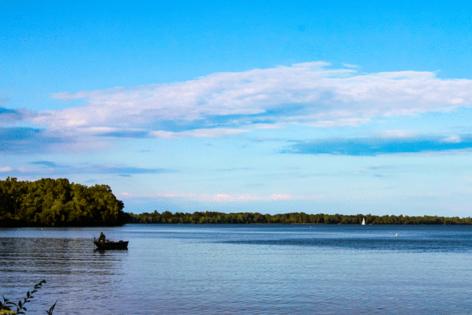Scientists predict Lake Erie's algae bloom will be smaller than last year
Published in News & Features
DETROIT — Water quality scientists predict the harmful algae bloom on western Lake Erie this year will be relatively mild and less severe than last year.
The bloom will be between mild and moderate levels, the scientists said Thursday. Moderate blooms are more likely to have patches of visible scum.
The bloom will start in early July, peak in August and last into September, the scientists from National Oceanic and Atmospheric Administration predicted in their annual forecast. Wind will impact the bloom's size and location, although they expect it to remain in the lake's western basin.
"It doesn't suddenly appear as this huge blob that eats the western basin," said Rick Stumpf, a NOAA oceanographer who works on harmful algae bloom modeling. "It usually starts smaller."
Scientists from NOAA, Ohio Sea Grant, the University of Toledo and Heidelberg University in Tiffin, Ohio, convened Thursday at The Ohio State University's Stone Laboratory in Put-in-Bay, Ohio, to announce their forecast for this summer's bloom and explain the metrics they use to make predictions.
The annual event took place after President Donald Trump's administration made deep cuts to the federal workforce this spring. Job cuts included NOAA scientists at the Great Lakes Environmental Research Laboratory in Ann Arbor who are key to the government's harmful algae bloom research and monitoring efforts.
Sean Corson, director of NOAA's National Centers for Coastal Ocean Science, estimated the federal science teams working on Lake Erie harmful algae bloom projects have each lost between 25% and 35% of their employees.
"With that said, NOAA is certainly committed to continuing (harmful algae bloom) forecasting going forward in the future, advancing toxin forecasting," he said. "It's going to take us a year or so, a season or so, to redistribute and work out how we're going to meet those challenges with a new workforce."
Algae blooms depend on nutrients, weather
Harmful algae blooms have become annual summer events in western Lake Erie. Inland lakes and other areas of the Great Lakes, including Saginaw Bay and near Duluth, also experience harmful algae blooms.
The cyanobacteria that cause the Lake Erie bloom thrive in its western basin, which is shallow, warm and receives high amounts of nutrients from rivers that run through heavy agricultural areas.
The Maumee River sends a significant level of concentrated nutrients to western Lake Erie. While it contributes just 5% of the western basin's water, it contributes 50% of its nutrients, said Nate Manning, interim director of Heidelberg University's National Center for Water Quality Research.
"What's coming out of the Maumee is concentrated, and that's very important to the algal blooms and their progression," he said.
Lake Erie algae blooms can be dangerous. Cyanobacteria can create microsytin toxins that are dangerous for people and pets.
Toxins tend to concentrate in surface scums that form during calm weather, Stumpf said. He warned people to stay away from scum and to check NOAA's algae bloom forecast tools to determine where the bloom is most likely to be present.
"The bloom is not everywhere when it occurs," Stumpf said. "It moves around a lot with the wind. It can be in the middle of the lake, it can be pushed to Ohio, then a few days later be pushed to Michigan and then pushed back around. It moves around a lot."
Scientists develop their annual harmful algae bloom forecast primarily based on the different kinds of and amount of phosphorus they detect in the Maumee River.
Blooms are larger when the Maumee River carries higher levels of phosphorus — particularly bioavailable phosphorus that can easily be consumed by cyanobacteria — from March through July. Heavy rains can carry more phosphorus into the water.
Blooms trend smaller because of progress and luck
Recent algae blooms have been less severe in Lake Erie in recent years than they were between 2008 and 2015, Stumpf said.
That may be because of a slight decrease in the amount of bioavailable phosphorus in the Maumee, but Stumpf cautioned against relaxing efforts to decrease nutrient runoff on farms.
"If we declare that we have solved this because they are small now, no," he said. "We're on the right (track) for reducing the phosphorus, but we can't control the rain and the runoff. We have to keep making progress in getting the phosphorus down if we want to keep these small blooms occurring."
Joel Brammeier, President and CEO of the advocacy group Alliance for the Great Lakes, said Michigan and Ohio need to take more drastic steps to reduce nutrients from running into waterways.
"Water utilities are addressing the symptoms to keep drinking water safe — but we are not treating all the root causes of the disease,” he said in an emailed statement.
The toxicity of the Lake Erie algae bloom is harder to predict. Scientists have found that nitrogen, another nutrient that runs into the water through rivers, determines how toxic the bloom becomes, while phosphorus dictates how large it will be.
Justin Chaffin, research coordinator for Ohio Sea Grant's Stone Laboratory, is working on a tool that will forecast bloom toxicity.
"It's a short-term forecast that is still in development, still in testing," he said. "It relies on grab samples, people on boats grabbing water samples, and remote sensing."
The warming climate is raising the stakes for people studying and living near the bloom. Cyanobacteria thrive in warm water. Stronger storms send more nutrients into the western basin, extended windless periods allow cyanobacteria to maximize their growth and additional carbon dioxide in the atmosphere gives cyanobacteria more to eat. Longer warm seasons also extend the bloom season.
Lake Erie started this season about 10 degrees cooler than it did last year — in the mid-60s instead of the mid-70s — but it is catching up, Stumpf said.
"It's been kind of warm in the last few days and I've been checking the temperature and it's literally been going up one degree Fahrenheit each day since June 20," he said.
---------------
©2025 www.detroitnews.com. Visit at detroitnews.com. Distributed by Tribune Content Agency, LLC.







Comments